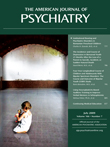Drs. Frye and Helleman Reply
To the Editor: Dr. Liebowitz comments on the safety (i.e., reduced switch rate) and effectiveness of morning single-dose immediate-release antidepressant therapy when there is a classic diurnal variation to the bipolar depressive episode. He further states that, conversely, extended-release antidepressant therapy may “tend to cause a reversal of diurnal variation, with improvement in the a.m. hours and agitation in the p.m. hours.” We find these observations intriguing and potentially meaningful.
This is not the first examination of diurnal variation and treatment response. We know that the presence of diurnal variation can be predictive of response to sleep deprivation in some but not all studies (1 , 2) . Second, patients with bipolar I disorder have responded more frequently to sleep deprivation than patients with major depression (3) . This may be related to Dr. Liebowitz’s observation of more pronounced diurnal variation in bipolar versus unipolar disorder.
Our study design utilized immediate-release antidepressants, and thus we are unable to comment on the potential extended-release liability or the proposed safety of morning-dose immediate-release therapy. However, we have gone back to conduct a secondary post hoc analysis of prevalence rate of diurnal variation to mood at the time of randomization. For this post hoc analysis, we utilized the Inventory of Depressive Symptomatology (4) question 9 rated mood that appeared to be related to the time of day as a score of 2. The rate of diurnal variation to mood was 14/44 (31.8%) in the treatment-emergent mania group, 25/83 (30%) in the antidepressant responder group, and 20/42 (46.5%) in the antidepressant non-responder group (χ 2 =3.49, df=2, p=0.18). Similarly, there was no difference among the three groups pertaining to mood being worse in the morning, afternoon, or evening.
Antidepressant response based on classic or reverse diurnal variation to mood in the context of antidepressant half-life is a very thought-provoking observation and worthy of controlled study.
1. Reinink E, Bouhuys N, Wirz-Justice A, van den Hoofdakker R: Prediction of the antidepressant response to total sleep deprivation by diurnal variation of mood. Psychiatry Res 1990; 32:113–124Google Scholar
2. Fahndrich E: Effects of sleep deprivation on depressed patients of different nosological groups. Psychiatry Res 1981; 5:277–285Google Scholar
3. Szuba MP, Baxter LR, Fairbanks LA, Guze BH, Schwartz JM: Effects of partial sleep deprivation on the diurnal variation of mood and motor activity in major depression. Biol Psychiatry 1991; 30:817–829Google Scholar
4. Rush AJ, Gullion CM, Basco MR, Jarrett RB, Trivedi MH: The Inventory of Depressive Symptomatology (IDS): psychometric properties. Psychol Med 1996; 26:477–486Google Scholar



